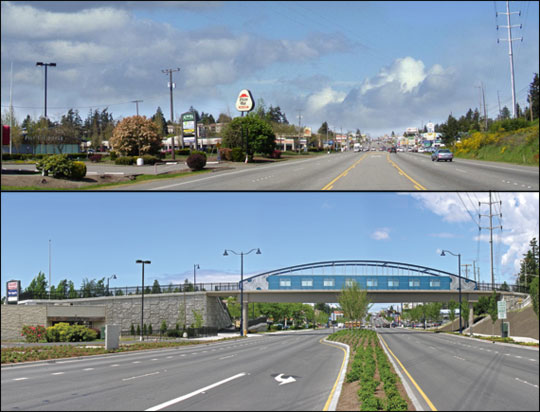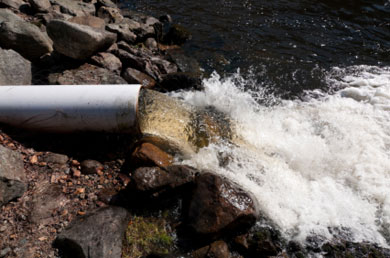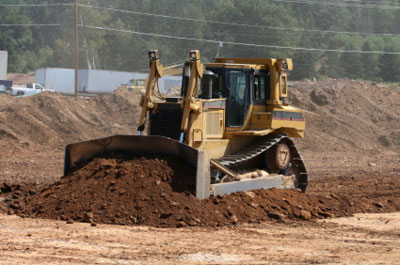CH2M HILL What Makes a Roadway Green?
A “green” roadway is not defined by its color but by its ability to fit into a community and to enable user-friendly connectivity for all potential travel modes. It highlights the strengths of its surroundings and brings people together in a safe and healthy way. In short, a green road supports sustainability, which can be complicated to define. For the Port of Long Beach, it means providing “an understanding and appreciation that long-term economic vitality is fundamentally tied to community integrity and to its ability to protect and preserve the earth – now and for future generations.”1
The Federal Highway Administration (FHWA) views sustainable highways as “an integral part of sustainable development. They should satisfy life-cycle functional requirements of societal development and economic growth while striving to enhance the natural environment and to reduce consumption of natural resources. The sustainability characteristics of a highway should be assessed and considered from conception through construction and in maintenance and operations throughout its lifecycle.”2
Transportation infrastructure connects communities and businesses. The strength of an economy is directly related to its ability to transport people and goods. A road becomes “green” when it not only connects communities and enables economic growth, but also matches the character of a community, helps it grow, and protects and enhances the environment surrounding it, and the planet as a whole.
Creating Access and Equity
A road compliments a community when it considers both the built and the natural environment that surrounds it. A green road is designed using Context Sensitive Solutions (CSS) and has cultural and educational outreach throughout the design process. CSS challenges the roadway designer to look beyond lanes and cars with questions such as: Who will be using the roadway? How will it be compatible with place and context? What is the land use along the corridor? Is the roadway adjacent to, or serve as a thoroughfare for, public transit? If this is an urban arterial, what business types line the street, and is there significant pedestrian traffic? And, if this is a small residential roadway, are there sidewalks and bike lanes for children who commute to school? Ultimately, every roadway is unique, and a large part of its “greenness” is based on access and equity.
Washington State’s City of Shoreline used CSS in its 1-mile urban arterial, which was part of the Aurora Multimodal and Interurban Bridges Project. It met the City’s goals for improved pedestrian and vehicle safety, pedestrian and disabled access, vehicular capacity, traffic flow, transit speed and reliability, nighttime visibility and safety, stormwater quality, economic investment potential and streetscape amenities. However, CSS’ success is ultimately reflected in the dramatically changed street environment.

© CH2M Hill|Before and after the Aurora Multimodal and Interurban Bridges Project
in the City of Shoreline, Washington
Pedestrian, bicycle and transit access all considerably affect the environment of the areas adjacent to the roadway and contribute to the roadway right-of-way transformation. Creating an inviting landscape, which affords a sense of safety to those using the facilities, has the ability to stimulate economic activity and provide new community gathering places. Primary aids in the creation of this type environment include site vegetation; historical, archeological and cultural preservation; and scenic, natural or recreational qualities.
Protecting Wildlife
Transportation is notorious for its large, negative environmental impacts, which is why a green roadway also mitigates or negates those impacts while enhancing the environment. Roadway sustainability can be improved considerably by capturing and treating runoff, incorporating site vegetation that fits into the local environment, performing habitat restoration, ensuring ecological connectivity, and reducing light pollution and traffic emissions. Improving wildlife access and mobility across roadway facility boundaries and reducing vehicle wildlife collisions and related accidents are also green roadway goals.
The success of ecological connectivity in roadway construction can be seen in the installation results of roadway over and underpasses for deer and other animals in Wyoming. The first project initiated by the State’s Department of Transportation (WYDOT) in collaboration with the Wyoming Game and Fish Department addressed the high number of highway vehicle and deer collisions along U.S. Highway 30, which led to further State investments and improvements. 3
Maintaining migration pathways and minimizing wetland impacts are critical to habitat survival near roadway projects. In order to mitigate roadway impacts and offset ecosystem degradation, additional preservation or restoration areas should be incorporated into the project beyond what is required by laws or regulations.
Capturing Water Resources
Roadway construction and expansion lead to increased pavement surface area, creating greater runoff amounts, which affect adjacent waterways and/or stormwater infrastructure. This creates increased amounts of sediment and pollutants that collect in nearby waterways and, in some coastal areas, in the ocean as local stormwater infrastructure meets capacity and spills over to prevent system backup. In rural areas, a slight increase in water elevation within a neighboring wetland can dramatically alter animal and plant life inhabitants. In U.S. urban environments, additional roadway runoff adds stress to an already overburdened local stormwater capture system that, in most cases, is past life expectancy.

© iStockphoto.com/clagge
Many possible treatments exist to address this negative roadway runoff. These include using infiltration-based practices, evapotranspiration (ET), project footprint and soil impact area reduction, permeable hard surfaces, and amended or engineered soils instead of conventional compacted soils. Something as simple as narrowing travel lanes can reduce the amount of disturbed soil and vegetation, which reduces excessive pavement surfaces that contribute to runoff. Permeable hard surfaces such as porous asphalt, porous pavers and porous concrete also reduce runoff amount. The idea is to mimic nature by absorbing and slowing down stormwater.
If roadway design is unable to reduce runoff, water treatment can be a potential solution. Treating 80 percent of total runoff volume to address pollutants will make a roadway greener. Infiltration best practices such as dispersion and biorention are options that can be used as substitutes for enclosed drainage systems. Adding site vegetation beyond aesthetic improvements also assists with stormwater capture and treatment. Bioswales, median landscaping and sidewalk buffers can serve as corrective treatment for sediments and runoff. Groundwater replenishment is an added benefit to the environment, ecosystem and local water supply. However, it is important to verify that the vegetation is both non-invasive and native, and that after the plant establishment period is complete, irrigation is not required.
The Aurora Project roadway design greatly reduced the net impervious surfaces for the project area by adding landscaped buffers, medians and other planted areas. Prior to the project, the previous roadway area was entirely covered with impervious surfaces consisting of paved lanes and shoulders. The new design creates more than 12,000 square feet of pervious surfaces, which is approximately 15 percent of total project area.
Incorporating a Green Mix
By recycling or using regional materials, the vehicle travel miles associated with construction are reduced and natural resources preserved. New or recycled road pavement construction materials can also be chosen to maximize project life while minimizing impacts on the surrounding environment. Reusing 80 to 95 percent of existing pavement materials, such as, but not limited to, hot mix asphalt (HMA), portland cement concrete (PCC), unbound granular base material and stabilized base material, limits fuel use associated with production of new materials and reduces transportation required for materials production and site delivery.
In addition, incorporation of alternative pavement solutions can greatly affect roadway project environmental impacts. Options such as warm mix asphalt, permeable pavement, cool pavement, quiet pavement or long-life pavement help minimize damage to the planet. Warm mix asphalt, one replacement to HMA, requires a lower plant mixing temperature and, therefore, reduces fuel used in plant production by at least 20 percent. Concrete mix sustainability can also be improved by using less manufacturing energy via an ENERGY STAR-certified cement production plant. An HMA or cement plant can also decrease project footprint by burning recycled oil, waste materials or other fuel saving technologies during materials production.
Additional cost savings can be realized by incorporating long-life pavement design, which focuses on life-cycle cost instead of minimizing short-term budget with lower quality pavement. A roadway sustainability goal is for 75 percent of new or reconstructed trafficked pavement lanes to be constructed with long-life pavement.
Going Green with Bulldozers
Significant improvements to roadway sustainability can also be made in the construction phase. By establishing project construction environmental training, a construction Quality Control Plan, a construction Noise Mitigation Plan and a Construction and Demolition Waste Management Plan, a project manager can ensure site workers are fully educated on the project’s sustainability goals. Additional benefits can come from arranging a pavement warrantee with the contractor, which guarantees pavement material quality and craftsmanship.

© iStockphoto.com/kozmoat98
Types of on-site construction vehicles can also significantly impact the project’s environmental footprint. Examples include vehicles that have engines meeting current Environmental Protection Agency (EPA) Tier 4 emission standards or that have diesel retrofit devices for after-treatment pollution control verified by EPA or California Air Resources Board (CARB). Design constructability can also improve project sustainability by reducing vehicle miles traveled associated with construction vehicles either on-site or in materials delivery. Beyond on-site pavement recycling, improved roadway grading also reduces construction trips.
One of the most important aspects the design engineer can focus on is grading surrounding the roadway and its elevation in relation to its surroundings. This requires the engineer to contemplate the vertical location of the roadway down to the smallest detail, thus literally fitting it into its surroundings. This may mean matching the height of the grocery store’s driveway, so the entrance isn’t too steep, or guaranteeing the landscaping next to the sidewalk transitions smoothly to a store’s entrance.
Another important design consideration is the soil amount required to be added or removed from a site below or above the proposed roadway – known as “earthwork.” A good roadway engineer always tries to balance his/her earthwork quantities so the amount of dirt added (fill or embankment) equals the amount of dirt removed (cut or excavation), not only because of associated cost, but also to improve project constructability. Reducing truck hauling through earthwork balancing is an ideal focus area for roadway sustainability. To achieve substantial roadway impact, the difference between cut and fill should be less than or equal to 10 percent of average total volume of material moved.
Sharing Benefits & Knowledge Transfer
As green transportation design becomes more common, transit operators, transportation agencies and state departments of transportation will measure the sustainability of their roads and highways. Doing so provides a marketing and public accountability tool for owners and operators to show they are responding to the public’s desire for more green roads. Many groups have developed rating systems that measure and quantify roadway project sustainability, similar to LEED, the preferred rating system for vertical infrastructure/buildings.
With many groups looking to develop this type of criteria and to learn from examples, a system of “open-source” information sharing has emerged. Similar to “open-source” software development, each rating system builds off others and enables a wider audience of viewers, reviewers and potential creators. This ensures each rating system does not “re-invent the wheel” and encourages subject matter experts to contribute, which further strengthens these systems. Additionally, the open aspect of system development encourages stakeholder involvement and shows constituents, who are demanding sustainable transportation design, that progress is being made in this area. The ultimate goal is to broaden thinking and to encourage knowledge transfer. This continued collaboration will increase the inclusion of sustainable elements in projects throughout the country, and reward designers and operators who understand how to incorporate these elements while educating those who do not. As rating systems are adopted and implemented, more and more engineers and designers are introduced to sustainable design elements and feel comfortable incorporating them into their designs at an early phase.

© iStockphoto.com/mills21
Rating systems include the Sustainable Transportation Analysis Rating System (STARS), Greenroads™, and the Federal Highway Administration (FHWA) Sustainable Highways Self-Evaluation Tool. STARS was created by a non-profit established by the City of Portland and developed in partnership with other organizations and consulting firms. Another rating system where the open-source philosophy has led to creation of additional project rating criteria programs and new project selection requirements is Greenroads. The University of Washington and CH2M HILL created this system to rate sustainable roadway design and construction at the project level. The developers recently established the independent third party Greenroads Foundation, which is currently test rating projects and will soon provide certifications.
Another system developed by CH2M HILL, as Prime Contractor to FHWA, is the FHWA Sustainable Highways Self-Evaluation Tool. This evaluation tool is unique because, unlike other rating systems, the initial October 2010 beta took into account the full life-cycle of highways, including system planning, project development, and operations and maintenance of an entire network. FHWA released the pilot test version, specifically for testing projects, on Earth Day, April 22, 2011, at www.sustainablehighways.org. This version responds to industry input on the beta version for the tool’s project development portion. In 2011, FHWA will continue project testing, with further refinement of the system planning and operations and maintenance portions of the tool.




























